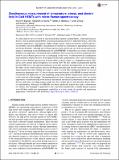| dc.contributor.author | Moore, Elizabeth A. | |
| dc.contributor.author | Badescu, Stefan C. | |
| dc.contributor.author | Wang, Evelyn N. | |
| dc.contributor.author | Bagnall, Kevin R. | |
| dc.contributor.author | Zhang, Lenan | |
| dc.contributor.author | Wang, Evelyn | |
| dc.date.accessioned | 2019-01-14T16:43:59Z | |
| dc.date.available | 2019-01-14T16:43:59Z | |
| dc.date.issued | 2017-11 | |
| dc.date.submitted | 2017-05 | |
| dc.identifier.issn | 0034-6748 | |
| dc.identifier.issn | 1089-7623 | |
| dc.identifier.uri | http://hdl.handle.net/1721.1/120023 | |
| dc.description.abstract | As semiconductor devices based on silicon reach their intrinsic material limits, compound semiconductors, such as gallium nitride (GaN), are gaining increasing interest for high performance, solid-state transistor applications. Unfortunately, higher voltage, current, and/or power levels in GaN high electron mobility transistors (HEMTs) often result in elevated device temperatures, degraded performance, and shorter lifetimes. Although micro-Raman spectroscopy has become one of the most popular techniques for measuring localized temperature rise in GaN HEMTs for reliability assessment, decoupling the effects of temperature, mechanical stress, and electric field on the optical phonon frequencies measured by micro-Raman spectroscopy is challenging. In this work, we demonstrate the simultaneous measurement of temperature rise, inverse piezoelectric stress, thermoelastic stress, and vertical electric field via micro-Raman spectroscopy from the shifts of the E2(high), A1longitudinal optical (LO), and E2(low) optical phonon frequencies in wurtzite GaN. We also validate experimentally that the pinched OFF state as the unpowered reference accurately measures the temperature rise by removing the effect of the vertical electric field on the Raman spectrum and that the vertical electric field is approximately the same whether the channel is open or closed. Our experimental results are in good quantitative agreement with a 3D electro-thermo-mechanical model of the HEMT we tested and indicate that the GaN buffer acts as a semi-insulating, p-type material due to the presence of deep acceptors in the lower half of the bandgap. This implementation of micro-Raman spectroscopy offers an exciting opportunity to simultaneously probe thermal, mechanical, and electrical phenomena in semiconductor devices under bias, providing unique insight into the complex physics that describes device behavior and reliability. Although GaN HEMTs have been specifically used in this study to demonstrate its viability, this technique is applicable to any solid-state material with a suitable Raman response and will likely enable new measurement capabilities in a wide variety of scientific and engineering applications. | en_US |
| dc.description.sponsorship | Massachusetts Institute of Technology. Microsystems Technology Laboratories. GaN Energy Initiative | en_US |
| dc.description.sponsorship | Singapore-MIT Alliance for Research and Technology Center. LEES Program | en_US |
| dc.description.sponsorship | United States. Air Force. Air Force Research Laboratory. High-Reliability Electronics Virtual Center | en_US |
| dc.description.sponsorship | United States. Air Force. Office of Scientific Research (National Defense Science and Engineering Graduate (NDSEG) Fellowship, 32 CFR 168a) | en_US |
| dc.publisher | AIP Publishing | en_US |
| dc.relation.isversionof | http://dx.doi.org/10.1063/1.5010225 | en_US |
| dc.rights | Article is made available in accordance with the publisher's policy and may be subject to US copyright law. Please refer to the publisher's site for terms of use. | en_US |
| dc.source | Other repository | en_US |
| dc.title | Simultaneous measurement of temperature, stress, and electric field in GaN HEMTs with micro-Raman spectroscopy | en_US |
| dc.type | Article | en_US |
| dc.identifier.citation | Bagnall, Kevin R., Elizabeth A. Moore, Stefan C. Badescu, Lenan Zhang, and Evelyn N. Wang. “Simultaneous Measurement of Temperature, Stress, and Electric Field in GaN HEMTs with Micro-Raman Spectroscopy.” Review of Scientific Instruments 88, no. 11 (November 2017): 113111. | en_US |
| dc.contributor.department | Lincoln Laboratory | en_US |
| dc.contributor.department | Massachusetts Institute of Technology. Department of Mechanical Engineering | en_US |
| dc.contributor.mitauthor | Bagnall, Kevin R. | |
| dc.contributor.mitauthor | Zhang, Lenan | |
| dc.contributor.mitauthor | Wang, Evelyn | |
| dc.relation.journal | Review of Scientific Instruments | en_US |
| dc.eprint.version | Final published version | en_US |
| dc.type.uri | http://purl.org/eprint/type/JournalArticle | en_US |
| eprint.status | http://purl.org/eprint/status/PeerReviewed | en_US |
| dc.date.updated | 2019-01-10T17:03:57Z | |
| dspace.orderedauthors | Bagnall, Kevin R.; Moore, Elizabeth A.; Badescu, Stefan C.; Zhang, Lenan; Wang, Evelyn N. | en_US |
| dspace.embargo.terms | N | en_US |
| dc.identifier.orcid | https://orcid.org/0000-0002-5042-4819 | |
| dc.identifier.orcid | https://orcid.org/0000-0001-7045-1200 | |
| mit.license | PUBLISHER_POLICY | en_US |
